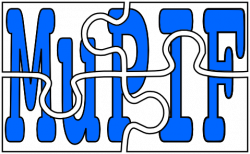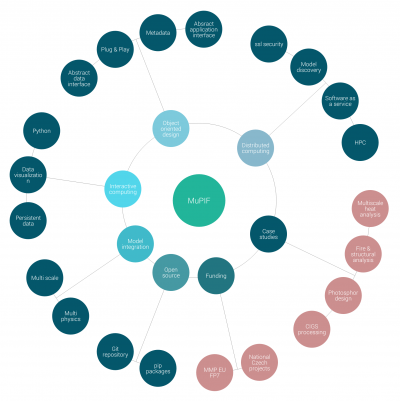Table of Contents
MuPIF
 A reliable multiscale/multiphysics numerical modeling requires including all relevant physical phenomena along the process chain, typically involving multiple scales, and the combination of knowledge from multiple fields. A pragmatic approach lies in combining existing tools, to build a customized multiphysics simulation chains. In order to achieve such a modular approach a multiphysics integration framework, called MuPIF has been designed, which provides an underlying infrastructure enabling high-level data exchange and steering of individual applications.
A reliable multiscale/multiphysics numerical modeling requires including all relevant physical phenomena along the process chain, typically involving multiple scales, and the combination of knowledge from multiple fields. A pragmatic approach lies in combining existing tools, to build a customized multiphysics simulation chains. In order to achieve such a modular approach a multiphysics integration framework, called MuPIF has been designed, which provides an underlying infrastructure enabling high-level data exchange and steering of individual applications.
Description
Framework Design
One of the main objectives is to develop an integrated modelling platform targeted to multiscale and multi-physics engineering problems. The approach followed in MuPIF is based on an system of distributed, interacting objects designed to solve given problem. The individual objects represent entities in the problem domain, including individual simulation packages, but also the data, such as fields and properties. The abstract classes are introduced for all entities in the model space. They define a common interface that needs to be implemented by any derived class, representing particular implementation of specific component. Such interface concept allows using any derived class on a very abstract level, using common services defined by abstract class, without being concerned with the implementation details of an individual software component. This essentially allows to manipulate all simulation tools using the same interface. Moreover, as the simulation data are represented by objects as well, the platform is independent on particular data format(s), as the exchanged data (such as fields and properties) can be manipulated using the same abstract interface. Therefore, the focus on services is provided by objects (object interfaces) and not on underlying data itself.

The complex simulation pipeline developed in MuPIF consists of top-level script in Python language (called scenario) enriched by newly introduced classes. Even though the platform can be used locally on a single computer orchestrating installed applications, the real strength of the MMP platform is its distributed design, allowing to execute simulation scenarios involving remote applications. MuPIF provides a transparent distributed object system, which takes care of the network communication between the objects when they are distributed over different machines on the network. One can just call a method on a remote object as if it were a local object – the use of remote objects is (almost) transparent. This is achieved by using the concept of proxies representing remote objects, which forward the calls to the remote objects and pass the results back to the calling code. In this way, there is no difference between simulation script for local or distributed case, except for the initialization, where, instead of creating local object, one has to connect to the remote object.
Implementation
Rather than writing programs, the Python language will be extended by modules, representing interfaces to existing codes, with specific functionality. The emphasis will be on building infrastructure to facilitate the implementation of multi-physic and multi-level simulations. The high-level language serves as a “glue” to tie the modules or components together, to create specialized application. Python language provides the flexibility, interactivity, and extensibility needed for such an approach, thanks to its concise and pseudocode-like syntax, modularity and object-oriented design, introspection and self documentation capability, and the availability of a Numerics extension allowing the efficient storage and manipulation of large amounts of numerical data. The application interface can be conveniently realized by wrapping application code. The process of wrapping code can be automated to a fair extent using SWIG~\cite{Swig}, Boost~\cite{Boost}, or similar tools, which can generate wrapper code for several languages. This approach also allows a single source version of the component code to be maintained.
Documentation
- Online User manual
How to get MuPIF
The easiest installation happens through Python Package Index (pip) which takes care of dependencies and installs/updates missing modules automatically. Run as a command
pip install mupif
Alternatively, you may install MuPIF from git repository. You have to take care yourself on depending modules (Pyro4, numpy, scipy, setuptools, enum34, pyvtk, future).
Demonstration of platform use
Resources
Related tools
- Python Programming Language, http://www.python.org/.
- Boost - C++ wrapper generator, http://www.python.org/.
- Pyro project home page, http://pyro.sourceforge.net/.
Related Publications
- B. Patzák, D. Rypl, and J. Kruis. Mupif – a distributed multi-physics integration tool. Advances in Engineering Software, 60–61(0):89 – 97, 2013 (http://www.sciencedirect.com/science/article/pii/S0965997812001329).
- B. Patzák. Design of a multi-physics integration tool. In B. H. V. Topping, J. M. Adam, F. J. Pallares, R. Bru, and M. L. Romero, editors, Proceedings of the Seventh International Conference on Engineering Computational Technology, Stirlingshire, United Kingdom, 2010. Civil-Comp Press. paper 127.
- B. Patzak, V. Smilauer, and G. Pacquaut, presentation & paper “Design of a Multiscale Modelling Platform” at the 15 th International Conference on Civil, Structural, and Environmental Engineering Computing, 1st - 4th of September 2015, Prague (Czech Republic).
Authors & Credits
Mupif developpers:
- Bořek Patzák (Lead Developper)
- Vit Šmilauer
- Guillaume Pacquaut
- Václav Šmilauer
- Former developpers: Daniel Rypl, Jaroslav Kruis
Acknowledgements
- The development of MuPIF has been funded by Grant Agency of the Czech Republic - Projects No. P105/10/1402.
- The development is at present supported by the EU project Multiscale Modelling Platform: Smart design of nano-enabled products in green technologies, project number 604279.